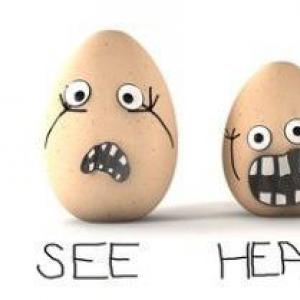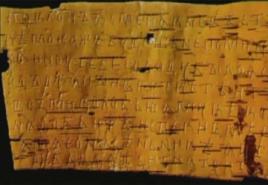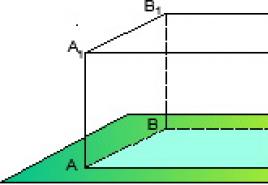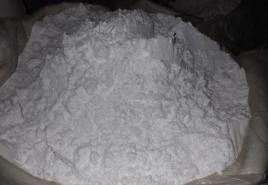Cilic larva. Cellwork officials
Theory for preparing for block No. 4 of the EGE on biology: with estimat and variety of organic world.
Type flat worms
Flat worms- Type of the most primitive three-layer animals. Unlike the intestinal, they have a third (medium) germinal sheet - mesoderma.
Body shape flat wormsAs follows from the type of type, flattened. They are bilaterally symmetrical, that is, only one plane of symmetry can be carried out through the body. This type of symmetry for the first time appears during the evolution of plane worms.
The body is not segmented, in the front end there is a pillow, which leads to the intestinal cavity. This is flat worms similar to intestinal. However, in contrast to them, in the body of flat worms, it is not possible not just diffusely scattered cells different types, and already clearly formed fabrics. Fabrics form organs, organs make up the system: digestive, excretory, nervous and polit.
Breathing and blood system are missing. Gas exchange is carried out directly through body cover, so the flat shape of the body profitably increases the surface area of \u200b\u200bthe gas exchange.
The space between the internal organs and the body wall is filled parenkhima -non-specialized fabric from the middle embryo sheet, mesoderm. Parenchima serves for pampering and vehicles of substances, maintains the body shape and serves as a support for the internal organs.
Covers and muscles
Epithelial and muscular fabric are separate, they are separated by the interlayer of the connective tissue. Together, these three tissues form the wall of the body of worms, which is called skin-musical bag. Usually, the outer layers of muscular cells are ring-shaped, that is, when they are reduced, the body of the worm is narrowed and pulls out. The inner layers of muscles have a longitudinal location, with their help the worm can shorten and bend in different directions. In addition, there are dorgeredral (spinal abdominal) beams Muscles - they connect the abdominal and spinal pieces of the animal. With their reduction, the body is compact.
Digestive system
The digestive system consists of anterior intestine ( gLAGE), formed by the ectoderma, and the average entodermal intestine, in which the digestion actually occurs. The rear and the anal hole is not, so the remnants of undigested food are returned to environment Through the oral hole.
The nervous system of flat worms is much more complicated than that of intestinal. Here is its characteristic differences:
- nervous cells are assembled in ganglia, which in turn are associated into nervous trunks;
- nervous cells are located deeper in the body, which allows them to secure them;
- occurs cephalization, that is, ganglia, located closer to the head, play a more important role in body management;
- oligomerization Nervous centers, that is, a decrease in their number as the body becomes complicated.
In the forefront of the body there is a large brain gangli, from which two nerve trunks depart. Trunks are connected by transverse jumpers, why such a system was named ortogona(This refers to orthogonal, that is, the perpendicular location of the nerve trunks).

Selective system
Vital products, often toxic for cells, accumulate in tissue fluid. Unlike intestinal, flat worms do not have the ability to highlight the exchange products directly external environmentThis requires a separate system.
The excretory system consists of branching tubules of ectodermal origin - protonfridiev. Each channel ends with a star-shaped cell - crytocyt. On the zirtocytes are bunches of cilia. When bias cilia resembling flickering flame, It occurs the movement of the tissue fluid into the tube protonfritis. All channels fall into larger ducts that open on the body surface. excretory holes. Thus, fluid with the exchange products falls out.

In some species in the back of the body, excretory channels are expanding, forming a bladder. It accumulates and concentrate the exchange products. Using an excretory system from the body, an excess liquid may also be removed, which is especially important for freshwater shapes. Without this mechanism, freshwater worms simply could not support the water-salt balance.
Sex system
Most of the flat worms are hermaphrodites. Separate glands are located in the depths of the body, the genuine cells are displayed in drives. The organization of the sexual system can differ significantly among representatives of different species.
Men's sex glats - semencons. From them to the co-focus ( zirrus) There are seeds. In the female sex system there are ovaries, yolocheries, ovage and vagina, opening in a sex clock. Yellowaniks are similar in structure with ovaries, but contain yellow cells- Sterile eggs with a large supply of nutrients for the future egg.
Classification
Flat worms include five classes, of which in school course Consider only three.
Class Silver Class (Turbellaria)
The class has more than 3,500 species. Unlike other flat worms, most turbellaria free-lived. Characteristic representatives of the class - planearia (dairy, burying, mourning, black, etc.). They live in fresh water, in large quantities are found in standing and slow reservoirs, hide under stones or leaves of plants. The size of the ciliated worms - from 2-3 mm to 30 cm.



The body is flat, thickened in the middle. In the early terminus there may be increased. With the help of the cilia and the skin-muscular bag of worms can crawl along various surfaces or sailing. The river hole is usually located in the middle body.
In the epithelium turbellarium, single-cell glands, which distinguish the mucous or protein secret. The mucus probably helps move and attach to the substrate, serves to protect. The protein secret can be toxic, which scares other predatory animals.
Most of the cereal worms are predators. They have a spreading throat, with the help of which you can breed production or tear pieces from it. If the body of the victim is covered with a chitine shell, the worm throws the digestive enzymes to the outside and softening hard covers. Interestingly, the planaries can use "weapons" of intestinal: when the worm eats the hydra, its cutting cells are not cleaving, and migrate through the wall of the body, turning to the worm's epithelium, protecting it from enemies.
Since turbellaria lead an active lifestyle, they have quite well developed organs of feelings. The whole body is covered with special long sensitive cilias, sensilla. They perceive mechanical or chemical irritation. Also almost all of the cilly there are equilibrium organs and two or more photosensitive eyeswhich are located in the head or evenly along the edge of the body.
Cille worms Hermaphrodites, internal fertilization, most often crossed, that is, partners take turns fertilize each other. The sperm is usually introduced into the sex clock, but sometimes directly into the body of the worm (in this case, the composite body is pushing the cover of a partner). After that, the spermatozoa moves to the eggs and fertilize them.
Development can be straightforward (from the egg there is an individual, similar to an adult) or with transformation (from the egg there is a larva with cilia).
Turbellaria is well regenerated: a full-fledged adult organism can develop from a small piece of body. Upon the occurrence of unfavorable conditions of the planearia, the usual breaks into parts and in this form to lose for a long time. After improving the conditions of pieces, new organisms regenerate. This is an example of a crucible reproduction of cilia worms.
Saler Class (Trematoda)


The nervous system is formed by a pair of head ganglia. Two jumpers connecting ganglia form formal a nervous ring. Nervous trunks are departed from the ring forward and back.
Trematodes hermaphrodites. All seasons, the female sex system is represented by one branching ovary, yolkishniki and shell glands. Their ducts fall into the bag-shaped cavity, which goes into the uterus. The uterus opens into a sex clock. Nearby there is a comprehensive body where spermatozoa from two seeds come (rarely from one).
In fertilization, the seed falls into the sex clock, where the spermatozoa is moving toward egg cells. Fertilized eggs are surrounded by yolk cells, are covered with a shell and start moving out of the uterus.
Salted life cycle: worm passes several stages of development with the change of owners. Adult animal ( marita), capable of sexual reproduction, lives in the main owner - spinal. After fertilization, the eggs go into an external environment and fall into the water (most often with the feces of the owner). In water out of the egg goes miracidium, larva with cilia.
Miracidium is actively swimming and is looking for an intermediate owner, the mollusk of a certain species. For example, for the liver loser intermediate owner - small Prudovik. Penetrating inside the mollusk using a special trunk, the larva loses the cilia and becomes fixed sporous. The sporocyst shares the most punish, as a result, many larvae of a new generation is formed. They feed on the mollusk tissues and continue to multiply. As a result, the mollusk go cerciria - Tailing larvae, similar to adult Marit. Cerciria is attached to the leaves of coastal plants and are incisive. Cyst May be expected for a long time until it is eaten by the host animal. A person can get infected if he drinks raw water with tonging cysts.

The body resembles a thin ribbon, consists of a head, neck and set of segments. Due to the sealer structure of tape worms, also called chains. The length of the worms can reach 20-30 m. Such large individuals are called soliteraibecause they are usually found only alone.
Suckers and hooks are located on the head, with the help of which the worm is tightly cling to the intestinal wall. There are many segments behind the neck, each of which lives and develops independently.


The digestive system in belt worms is fully reduced: animals inhabit the intestines and suck the body with food treated by the host enzymes.
The breathing of the anaerobic type, so it is not completely cleaved by the oxidation of nutrients of glucose. Incomplete cleavage products are output and poison the host's body.
In each segment, the worm is the organs of excretory and sexual systems. The nervous system is developed extremely weak: two nervous trunks pass on the sides, and tactile cells are scattered in the epithelium.
Ribbon worms hermaphrodites. The genitals develop gradually: the youngest segments located next to the head may not have them at all. A large number of seeds with ducts are formed in the parenchym, which merge into the shared seed. The ovary is one, large, consists of several poles.
It is possible both cross-fertilization and self-exploitation, in which spermatozoa is introduced into the vagina of a neighboring or even a segment. As eggs ripening, the segment matures and eventually can break away from the worm body. Eggs fall out with the host feces and can settle on the leaves of plants.
When the egg swallows the intermediate owner, it comes out of it oncosphere, larva with six hooks. For bull Chain (TaeniaRhynchus Saginatus) intermediate owners are man-andotive, for pork chain (Taenia Solium) - Pigs, dogs, hares and rabbits. Finding into the intestine of the animal, the oncosphere triggers its wall and goes into the bloodstream, settling in any organ. There the larva is converted to finnand waiting for it to fall into the body of the next owner. Usually the infection occurs when the main owner eats intermediate. A person can get infected by eating poorly roasted meat.
In the intestine from the Finna, the head of the worm is turned out and fixes on the wall of the intestine. Young segments are isolated from the neck, the body chain is growing.


This class includes free-lived marine and freshwater, rarely terrestrial worms, the whole body of which is covered with a rash epithelium. The movement of worms is ensured by the work of cilia and cutting muscles. Many species are peculiar to regeneration.
Typical representative of cilia worms - White-white P Alan Aria - dwells in fresh standing reservoirs on underwater objects and plants (Fig. 11.4). Its flat body stretched in length, in the front end it is visible two small tactular tentacious growing and two eyes.
Planaria - a predatory animal. Her mouth is located on the abdominal side, almost in the middle of the body. With the help of protruding outward muscular pharynx, the plane penetrates the prey and sucks its contents. In the branching middle sector of the intestine, food is digested and absorbed.
Options - protonphridey. They are represented by two branching channels, at one end opening outwardly by excretory holes, and on the other - star cells scattered in the parenchyma. The star part of the cell goes into the channel, inside which is a bug of the cilia. Liquid exchange products are selected in the pear-shaped expansion of the initial section of the channel. Protonefridia are located on the sides of the body.
General characteristic type
Characteristic types of type are as follows:
Body flat His shape is sheet (at the cereal and seasters) or a belt-shaped (in tape worms).
For the first time in the animal world, representatives of this type developed bilateral (bilateral) body symmetry, i.e., through the body, it is possible to carry out only one longitudinal plane of symmetry, dividing it into two mirror-like parts.
In addition to Ektoderma and Entoderm, they still have a medium germinal sheet - mesoderm. Therefore, they are considered the first three-layer animals. The presence of three germinal leaflets gives the basis for the development of various organ systems.
Body wall forms knee-muscular bag - Summary of outdoor single-layer epithelium and several layers of muscles - ring, longitudinal, oblique and spinal abdominal. Therefore, the body of flat worms can make complex and varied movements.
Body cavity absent, Since the space between the body wall and the internal organs filled with loose mass of the cells parenkhima.It performs a reference function and serves as a depot of spare nutrients.
The digestive system consists of two departments: Etoder-Mal front intestine, represented by mouth and muscular throat capable of predatory cilia worms to turn outward, penetrate the victims and suck its contents, and blindly closed entodermal middle intestine. Many species from the main sections of the middle intestine, there are many blind branches penetrating into all parts of the body and delivering dissolved nutrients. Imaginary residues are thrown through the mouth.
Selective system protonphridial type. Excess water and final products of metabolism (mainly urea) are derived through excretory pores.
The nervous system is more concentrated and represented by pair head Ganglia and extending from him longitudinal nervous trunks connected ring jumpers. Nervous trunks are formed located along its entire length of the bodies of nerve cells and their processes. This type of organization nervous system called stem. All flat worms are developed by tanging, chemical feeling, equilibrium, and free-lived - and vision.
Dimensions - from microscopic up to 30-40 cm. Most of the free-lived species of cilia worms are found in the seas and fresh waters, fewer - in wet places on the surface of the sushi, in the soil. The most famous are the representatives of the three-letter detachment, or planaria (white, black, mourning, buoy, etc. - only about 100 species).
Free-lived flat worms eat predominantly as predators and move crawl or climb. Therefore, the skin-muscular bag and cilia contribute. Flat worms are the first bilateral symmetric animals. Body shape and skin-muscular bag The body is flattened, oval or extended. At the front end of the body, the senses are usually located. Roth is on the abdominal side of the body. The body of the turbellarium outside is covered with a single-layer semi-layer epithelium, and with age, the cilia is often lost, because of which the cells are like "bald". It is believed that the cilia contribute to the movement of the worm in space.

The digestive system of clarity worms is quite diverse within the class and varies from primitive - without a decorated intestine to a relatively complex - with a branched bowel. The main troops of the cylinder worms are primarily the intestinal form. The detachment of Potchenny (Acola) has a mouth on the abdominal side of approximately in the middle of the body. Switching food enters an entodermal parenchyma adjacent to the peripheral layer of mesodermal parenchyma.
A temporary food cavity surrounded by digestive cells is formed around the brewed lump of food. Thus, nutrients are initially provided by organs located in front of the body. In the cereal worms with a decorated intestine big role In digestion of food, sipstrokes are performed. Many species have extorted digestion. Often, planaria is attacked by rather major victims (mollusks, racks). In the body of the victim, they allocate digestive enzymes, and then suck the semi-stewed food.
Outline system protonphridial type. Usually there is one or two main channels, from which there are many branching small tubules ending with familicy cells - with zirtocytes. At the rear end of the body, the excretory channels open outwardly by excretory pores.
Castle worms - hermaphrodites. Each individual has female and men's sexes - gonads. Many species have a complex system Floor ducts and additional glands.
Men's gametes are formed in numerous small seeds (some of some fubs can only have two), scattered in the thickness of Parenhim. From each seed, a thin seven-way canal departs, which flows into a larger pair duct - the seed. Connecting, the seeds form a seedweight canal, located inside the composite body. The female genital system consists of sex glands - ovaries, modified gonad - yolocheans and female sex ducts.
Many tubellories are not formed. From the ovaries of the eggs enter the eggs (they are usually two), the tours of the sewers are opening there, for which the yolk cells are rich in nutrients. Combined, the eggs form the unpaired vagina, which opens to the sexual cloac. Tubellories can also multiply with use. In this case, a transverse hauling appears on the body, gradually separating the animal into two parts. Since some organs are available in the singular, then the individuals formed subsequently completing the necessary parts.
The world of the simplest is distinguished by the amazing variety of their representatives. Some of them are completely harmless, others are completely harmless to humans, unlike the causative agent of the disease, but carry a threat to other inhabitants of the animal world, like fish, mollusks.
For example, turbellaria, which refer to the type of flat worms. Crymfish, with its excessive reproduction in the aquarium, are able to destroy its inhabitants.
So what is turbellaria, and what lifestyle do cili worms behave? The class of ciliated has more than 3,500 types of worms. The most typical representative of this class is its other varieties (black, milky-white and so on).
Class Classified Cherry
The overall characteristic of the class of eyelash worms indicates that these organisms lead a predatory lifestyle, feed on small invertebrates, moved by either crawling, thanks to their cilia and a skin-muscular bag.
Representatives of the Class Class include:
- Planaria.
- Temcocephali.
- Udonellides.
- Turbellaria.
Phagotito-shaped cilia worms are considered the closest ancestors, that is, the wilderness occurred from once extinctish-sheep.
The latter at some stage of their evolution, were able to move to the crawling lifestyle at the bottom of the reservoirs, where they led the active life of the predator, hunting for small representatives of the Water World.
At first, the progenitors of flat worms floated along the bottom thanks to cilias on their body. Over time, there was a complication of their nervous and muscle systems, and due to the improvement of the mesoderm, the remaining structures of the body were also modified. As a result, the first class of flat representatives appeared - wilderness. Much later, other classes were formed: and.
Where are the wilderness worms inhabit? Most wilderness officials are found almost everywhere:
According to scientists, the appearance of the first fishing worms refers to the period of the Proterozoic Era.
Features of the structure and life of worms
Turbellaria live in water, like larvae, stand out slightly elongated body structure, the length of which reaches 30 -40 cm. However, there are separate instances with an oval or flattened form. Otherwise they do not have special differences From other similar organisms like themselves.

Features of the structure
It is very rarely found by the individuals of a worm with a colorless cover of the body, usually it has a variety of bright colors, thanks to the presence of a special skin pigment. Little cilia are located on the body surfaceperforming not only protective functions, but also contributing to the rapid movement of turbellaria.
True, the speed of movement depends not only on the presence of these cilias, and on the ability of skin muscles to reduce. So, what are the features of the building in the cereal worms?
Oral cavity
The mouth cavity in turbellaria can be located both at the beginning of the body, so in its center, therefore the digestive process occurs surprisingly easily and quickly. Perevide food is not delayed in the body, immediately go out.
Digestive system
The digestive system has a variety of For example, one subspecies is completely absent, the other is quite branched. It is according to this feature that the subspecies of these worms differ.
Invertebrates, after the food be digested and leaves the body, a new temporary digestive system begins to form, which disappears after the recycling of the next portion of food.
But the turbellaria with a branched bowel is carried out this process otherwise. In this case, the digestive stage is much more complicated, as food needs to be moved over all branches until it gets to the final stage of digestion. Useful substances travel throughout the body, enriching the body with the necessary elements. After that, the turbellarium feels forth for several days.
Circulatory structure
The structure of blood circulation is absent, and the breathing process itself is carried out by the surface of the body.
Nervous system
The nervous system is distinguished by a strong branching capable of capturing the slightest vibrations and vibrations, which are for the worm of danger.
Curious fact: On ring jumpers are insignificant endings of nerves capable of self-restoration after their removal.

Digestive and nervous system
There is a stateless turbellarium in an estateist, thanks to such a feature, the appearance of brain tissues around the end of the nerves is possible. Those worms that have no stavocist, the brain brain is formed at the beginning of their body.
Sense organs
Sensivities are notable for good development, so the turbellaria can catch even the most minor signals. Due to the presence of ciliates located throughout the body and having a connection with nervous process, the touch function works well.
System of smell
Vision
All representatives of the Class Classified Worms of the Eye are weakly shaped, they are not able to clearly distinguish the surrounding items. However, individual varieties of turbellaria have eyes. They are located next to the brain and can be counted in the number of two or several dozen, which are sharply reacting to light stimuli. The visual nerves, having received the necessary information, lightningly sends a signal to the brain, which analyzes the data obtained and the adoption of further actions.
Sex system
Turbellaria - hermaphroditesThat is, both are both male and female individuals. Sexual communication is carried out with the help of special channels located inside the worm. When the pairing process ends, fertilized eggs fall apart in the reservoir through small breaks on the body of the turbellaria.
Most of the representatives of the ciliation are inclined to a sexual reproduction - division into two halves, with further formation of missing bodies.

Turbellaria
It is no secret that the representatives of the Class Classified Worms are predisposed to regeneration, in other words, they can endure even the most adverse conditions for their lives, cheerfully remaining afloat in any circumstances.
Below is a comparative table of flat Classic Class Worms:
We deliver aquarium from the ciliary representative
Many aquarists are interested in how to get rid of turbellaria in aquarium? It should be said that these creatures are quite dangerous for the life of the inhabitants of the aquarium. Excessive amounts of these organisms can destroy fish and fry icrees. Specific sticks are present on the surface of the turbellaria (chance), which the worm shoots in their victim.
Getting into the body of the fish, she not only to apply it to her wound, and causes paralysis.
Such methods have proven to combat turbellaria:








